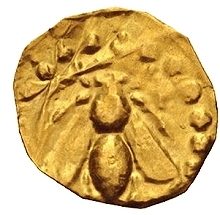
PREV ARTICLE
NEXT ARTICLE
FULL ISSUE
PREV FULL ISSUE
CHARON’S OBOL COINS FOR THE DEAD
While I'm not a collector of ancient coins, I do very much look forward to Mike Markowitz's articles in his Ancient Coin Series
for CoinWeek. I always learn something new. Here's an excerpt from his interesting May 2, 2016 article on coins for the dead.
-Editor

Offerings of food, tools, fresh flowers and red ochre (a mineral pigment) were carefully deposited in Neanderthal burials as far back as a hundred thousand years ago. We imagine that such “grave goods” were intended for the enjoyment of the dead in the afterlife. Within a century after the emergence of coinage in the seventh century BCE, coins begin to appear in ancient graves. One custom – but by no means the only one – was to place a single, low-value coin in the mouth of the deceased. Coins may be found in or near the hands of the deceased, at their feet, or scattered in the grave. Where cremation was the custom, burned coins are sometimes found with the ashes in an urn. From literary sources, we know that such coins were called “Charon’s obols”. Charon
The Obol
Obol coins are usually lighter than the theoretical weight. Ancient mints took a loss producing small change in precious metal, and often compensated by adjusting the weight downward. The Greek word “obol” originally meant “roasting spit,” because bundles of iron roasting spits served as a primitive form of money before coinage. Such skewers are occasionally found in ancient graves and tombs, perhaps in expectation of feasting in the afterlife. Burial customs are highly conservative, so the small coin might have served as a convenient symbolic substitute for the iron skewer. The Elusive Danake
Numismatists describe these as “uniface” – because the design appears on one side. They usually weigh between a half and a quarter of a gram, and measure 6 to 12 mm in diameter. Again, burial customs are very conservative, and in the absence of any inscription, provenance or context such pieces can only be dated in the most general terms (“fifth to first century BCE”, for example). One type shows a “radiate” head, probably the sun god Helios or Apollo. Another type depicts a honeybee, perhaps expressing a wish for a sweet afterlife.
The author concludes with commentary relevant to today's numismatic market and regulatory environment. -Editor
Ethics, Numismatics and the Dead
Those who seek to ban the private ownership and trade in antiquities would love to depict all ancient coin collectors as complicit with tomb robbers and looters of archaeological sites. The reality is far more complex[3]. Most ancient coins are found in hoards–ceramic pots deliberately buried at a distance from buildings and inhabited areas. Coins in graves were typically of low value when buried, and generally being common types in base metal, are of little value on the antiquities market today. We show respect for remains of the deceased, not because they care, or because it benefits them in any way, but because this is simply one of the things that makes us human. To read the complete article, see:

Wayne Homren, Editor The Numismatic Bibliomania Society is a non-profit organization promoting numismatic literature. See our web site at coinbooks.org. To submit items for publication in The E-Sylum, write to the Editor at this address: whomren@gmail.com To subscribe go to: https://my.binhost.com/lists/listinfo/esylum All Rights Reserved. NBS Home Page Contact the NBS webmaster 
|

